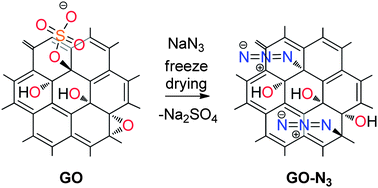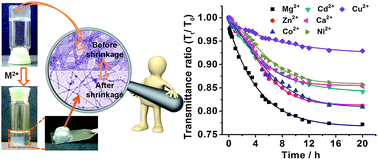
Juenguo
Shared posts
Mn2+-Doped Lead Halide Perovskite Nanocrystals with Dual-Color Emission Controlled by Halide Content
Making sense of chemical stories
Discussions on chemophobia (or whatever you want to call it) is a perennial favourite on chemistry blogs. But the conversation rarely extends out of our echo chamber. But now Sense about Science have joined the discussion with the publication of a guide entitled Making Sense of Chemical Stories.
Sense about Science is a respected charitable organisation that ‘equips people to make sense of scientific and medical claims in public discussion’. In short, they facilitate discussions between concerned/interested groups and relevant experts. The aim of their guide is to bridge the disconnect between the lifestyle view (and popular definition) of chemicals and the realities of how chemistry is used to support the modern world. It does this by tackling common misconceptions about chemistry.
One of the key misconception that they address is that natural chemicals are somehow safer than man-made ones. The wrongheadedness of which is nicely illustrated by a pair of infographics (designed by Compound Interest) that don’t shy away from admitting synthetic chemicals are often toxic but also make it clear that whether a chemical is naturally occurring or man-made tells us precisely nothing about its toxicity.
Making Sense of Chemical Stories is being promoted to the public, journalists, life-style press and policy makers. It, along with the infographics are freely available to download and distribute under a creative commons license. Or if you prefer a hard copy (or box full of them) email enquiries[ at ]senseaboutscience[dot]org with your contact details.
台湾反服贸运动演讲词全稿
Codelivery of siRNA and a cisplatin prodrug [Engineering]
Thermally Reversible Aggregation of Gold Nanoparticles in Polymer Nanocomposites through Hydrogen Bonding
Fluorogenic α-Tocopherol Analogue for Monitoring the Antioxidant Status within the Inner Mitochondrial Membrane of Live Cells
Well-Defined Polymeric Double Helices with Solvent-Triggered Destruction from Amphiphilic Hairy-Like Nanoparticles
Multi-Responsive and Logic Controlled Release of DNA-Gated Mesoporous Silica Vehicles Functionalized with Intercalators for Multiple Delivery
Novel DNA-gated mesoporous silica nanoparticle (MSN) vehicles functionalized with disulfide-linked acridinamine intercalators are constructed for multi-responsive controlled release. The DNA-gated MSN vehicles release cargo encapsulated in the MSN pores under different stimuli, including disulfide reducing agents, elevated temperature, and deoxyribonuclease I (DNase I), for codelivery of drugs and DNA/genes in different forms. Furthermore, the cascade release of encapsulated and intercalative drugs is controlled by AND logic gates in combination of dual stimuli. The ingeniously designed DNA-gated MSN vehicles integrates multiple responses and AND logic gate operations into a single smart nanodevice not only for codelivery of drugs and DNA/genes but also for cascade release of two drugs and has promising biological applications to meet diverse requirements of controlled release.

A single smart nanodevice: Native DNA-gated mesoporous silica delivery vehicles functionalized with disulfide-linked acridinamine intercalators integrate multiple responses and “AND” logic gate operations not only for codelivery of encapsulated drugs and DNA/genes but also for cascade release of encapsulated and intercalative drugs and has promising biological applications to meet diverse requirements of controlled release.
Phenformin/BRAF inhibitor combination in melanoma [Medical Sciences]
Yolk–Shell Structure of Polyaniline-Coated Sulfur for Lithium–Sulfur Batteries
Four-Way Junction-Driven DNA Strand Displacement and Its Application in Building Majority Logic Circuit
Multicomponent Reactions for de Novo Synthesis of BODIPY Probes: In Vivo Imaging of Phagocytic Macrophages
Selective Exo-Enzymatic Labeling of N-Glycans on the Surface of Living Cells by Recombinant ST6Gal I

A game of tag: N-Glycans on the surface of living cells were selectively tagged by exogenously administering recombinant ST6Gal I sialyltransferase and azide-modified CMP-Neu5Ac. This modification was followed by a strain-promoted cycloaddition using a biotin-modified dibenzylcyclooctynol (red star=biotin). The methodology will make it possible to dissect the mechanisms that underlie altered glycoconjugate recycling and storage in disease.
New Endeavors in Gold Catalysis—Size Matters

Golden times: Recent breakthroughs in gold-catalyzed transformations using nanosized homogeneous gold catalysts are highlighted. These catalysts have activities and stabilities comparable to (or even surpassing) heterogeneous catalysts. Well-defined, ligand-supported gold clusters turned out to be active in homogeneous catalysis, a catalyst concept which holds potential for future studies.
Upconverting Near-Infrared Light through Energy Management in Core–Shell–Shell Nanoparticles

Blue emission at NIR excitation: A strategy, based on energy management in nanostructured materials, is reported for photon upconversion of near-infrared light. Several optical processes can be integrated into a single nanoparticle (see picture). The effect offers upconversion emissions spanning from ultraviolet to the visible spectral region by excitation at 808 nm.
Neodymium-Doped LaF3 Nanoparticles for Fluorescence Bioimaging in the Second Biological Window
The future perspective of fluorescence imaging for real in vivo application are based on novel efficient nanoparticles which is able to emit in the second biological window (1000–1400 nm). In this work, the potential application of Nd3+-doped LaF3 (Nd3+:LaF3) nanoparticles is reported for fluorescence bioimaging in both the first and second biological windows based on their three main emission channels of Nd3+ ions: 4F3/2→4I9/2, 4F3/2→4I11/2 and 4F3/2→4I13/2 that lead to emissions at around 910, 1050, and 1330 nm, respectively. By systematically comparing the relative emission intensities, penetration depths and subtissue optical dispersion of each transition we propose that optimum subtissue images based on Nd3+:LaF3 nanoparticles are obtained by using the 4F3/2→4I11/2 (1050 nm) emission band (lying in the second biological window) instead of the traditionally used 4F3/2→4I9/2 (910 nm, in the first biological window). After determining the optimum emission channel, it is used to obtain both in vitro and in vivo images by the controlled incorporation of Nd3+:LaF3 nanoparticles in cancer cells and mice. Nd3+:LaF3 nanoparticles thus emerge as very promising fluorescent nanoprobes for bioimaging in the second biological window.

The future achievement of depth tissue real in vivo imaging requires the development of novel efficient infrared fluorescence nanoparticles. In this work, the potential application of Nd3+-doped LaF3 nanoparticles is reported for fluorescence bioimaging based on their three main emission channels of Nd3+ ions (first and second biological windows). High contrast and low toxicity are obtained, both in vivo and in vitro, using 1.06 μm.
Postsynthetic Functionalization of a Hollow Silica Nanoreactor with Manganese Oxide-Immobilized Metal Nanocrystals Inside the Cavity
DNA Protection by the Bacterial Ferritin Dps via DNA Charge Transport
Single Vehicular Delivery of siRNA and Small Molecules to Control Stem Cell Differentiation
Hypoxia-sensitive bis(2-(2[prime or minute]-benzothienyl)pyridinato-N,C3[prime or minute])iridium[poly(n-butyl cyanoacrylate]/chitosan nanoparticles and their phosphorescence tumor imaging in vitro and in vivo
DOI: 10.1039/C3NR04349E, Paper
Phosphorescent polymeric BTP derivative (btp)2Ir(PBCA)/CS NPs were prepared, which enhanced the tumor imaging effect significantly with lower toxicity.
The content of this RSS Feed (c) The Royal Society of Chemistry
Controlled functionalization of graphene oxide with sodium azide
DOI: 10.1039/C3NR04332K, Communication
Graphene oxide (GO) with an almost intact carbon framework is functionalized by azide on its surface preserving the basic structure.
The content of this RSS Feed (c) The Royal Society of Chemistry
A facile bacterial assisted electrochemical self-assembly of polypyrrole micro-pillars: towards underwater low adhesive superoleophobicity
DOI: 10.1039/C3NR03788F, Communication
By taking advantages of bacterial extracellular electron transfer behavior, a facile method was developed to fabricate oriented polypyrrole micro-pillars (PPy-MP) with nanoscale surface roughness. Microbe acted as a living conductive...
The content of this RSS Feed (c) The Royal Society of Chemistry
Controlling Mechanical Properties of Cell-Laden Hydrogels by Covalent Incorporation of Graphene Oxide
Graphene-based materials are useful reinforcing agents to modify the mechanical properties of hydrogels. Here, an approach is presented to covalently incorporate graphene oxide (GO) into hydrogels via radical copolymerization to enhance the dispersion and conjugation of GO sheets within the hydrogels. GO is chemically modified to present surface-grafted methacrylate groups (MeGO). In comparison to GO, higher concentrations of MeGO can be stably dispersed in a pre-gel solution containing methacrylated gelatin (GelMA) without aggregation or significant increase in viscosity. In addition, the resulting MeGO-GelMA hydrogels demonstrate a significant increase in fracture strength with increasing MeGO concentration. Interestingly, the rigidity of the hydrogels is not significantly affected by the covalently incorporated GO. Therefore, this approach can be used to enhance the structural integrity and resistance to fracture of the hydrogels without inadvertently affecting their rigidity, which is known to affect the behavior of encapsulated cells. The biocompatibility of MeGO-GelMA hydrogels is confirmed by measuring the viability and proliferation of the encapsulated fibroblasts. Overall, this study highlights the advantage of covalently incorporating GO into a hydrogel system, and improves the quality of cell-laden hydrogels.

Methacrylate is chemically grafted on the graphene oxide (GO) surface. Higher concentrations of the resulting methacrylated graphene oxide (MeGO) can be stably dispersed and conjugated within the hydrogels which improved fracture strength as compared with GO. In addition, cells maintain high viability within MeGO-linked hydrogels. Therefore, covalent incorporation of GO induces proper interfacial bonding between GO and the polymeric network, and ultimately improves the quality of cell-laden hydrogels.
Highly Luminescent Covalently Linked Silicon Nanocrystal/Polystyrene Hybrid Functional Materials: Synthesis, Properties, and Processability
Silicon nanocrystals (SiNCs) have received much attention because of their exquisitely tunable photoluminescent response, biocompatibility, and the promise that they may supplant their CdSe quantum dot counterparts in many practical applications. One attractive strategy that promises to extend and even enhance the utility of SiNCs is their incorporation into NC/polymer hybrids. Unfortunately, methods employed to prepare hybrid materials of this type from traditional compound semiconductor (e.g., CdSe) quantum dots are not directly transferable to SiNCs because of stark differences in surface chemistry. Herein, the preparation of chemically resistant SiNC/polystyrene hybrids exhibiting exquisitely tunable photoluminescence is reported and material processability is demonstrated by preparing micro and nanoscale architectures.

Highly luminescent, solution processable silicon nanocrystals/polystyrene hybrid materials are synthesized using size-independent radical-initiated hydrosilylation. Combining the properties of nanocrystals with polymer significantly increases solubility and processability, provides the opportunity to fabricate uniform nano- and microscale architectures, and renders silicon particles chemically resistant to prolonged exposure to strongly basic conditions.
A metal ion triggered shrinkable supramolecular hydrogel and controlled release by an amphiphilic peptide dendron
DOI: 10.1039/C3CC47004K, Communication
Divalent metal ions triggered the shrinkage of a supramolecular hydrogel and a controlled release of vitamin B1.
The content of this RSS Feed (c) The Royal Society of Chemistry
Photo-Thermo-Electric Converters: NIR-Sensitive Poly(3,4-ethylenedioxyselenophene) Derivatives for Transparent Photo-Thermo-Electric Converters (Adv. Mater. 38/2013)

The electrochromism and photothermoelectric properties of a poly(3,4-ethylenedioxyselenophene) derivative are investigated by precisely controlling the morphology and applied electrical potential of the flexible polymer films. On page 5483, Eunkyoung Kim and co-workers report a highly efficient and flexible photothermoelectric converter using doped poly(3,4-ethylenedioxyselenophene)s. Efficient visible to near-infrared absorption, photon to heat, and heat to electric conversion are realized in one polymer film.
25th Anniversary Article: Design of Polymethine Dyes for All-Optical Switching Applications: Guidance from Theoretical and Computational Studies
All-optical switching—controlling light with light—has the potential to meet the ever-increasing demand for data transmission bandwidth. The development of organic π-conjugated molecular materials with the requisite properties for all-optical switching applications has long proven to be a significant challenge. However, recent advances demonstrate that polymethine dyes have the potential to meet the necessary requirements. In this review, we explore the theoretical underpinnings that guide the design of π-conjugated materials for all-optical switching applications. We underline, from a computational chemistry standpoint, the relationships among chemical structure, electronic structure, and optical properties that make polymethines such promising materials.

Polymethine dyes have the potential to meet the stringent requirements for all-optical switching applications: that is, controlling light with light. Here, we review the theory behind the design of π-conjugated molecular materials for all-optical switching applications and examine the role of computational chemistry in exploring the optical properties of these systems
Enhanced Accuracy of Single-Molecule Diffusion Measurements with a Photocleavable Energy-Transfer Dyad

A photocleavable energy-transfer dyad was synthesized, characterized, and applied to single-molecule fluorescence microscopy. After photocleavage, a combination of independent two-color single-molecule tracking and analysis of single-molecule energy-transfer efficiencies allows the determination of the temporal evolution of the relative distances between both fragments from the nm to the μm scale. This gives access to a broad range of diffusion coefficients.















